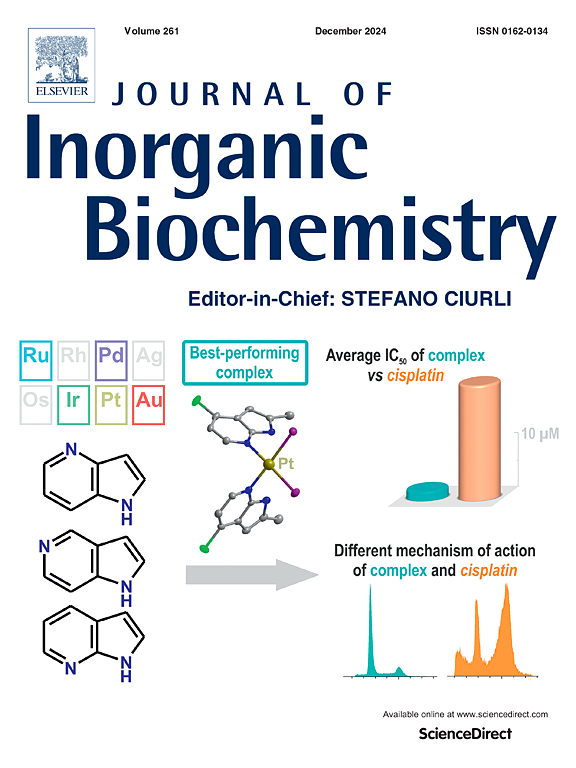杂双金属二茂铁色素化合物作为淀粉样蛋白聚集的选择性抑制剂
IF 3.8
2区 化学
Q2 BIOCHEMISTRY & MOLECULAR BIOLOGY
引用次数: 0
摘要
淀粉样蛋白聚集是神经退行性变的关键过程,产生有毒物质,促进疾病进展。这强调了迫切需要确定能够通过调节这种聚集过程来降低毒性的新型药物。研究了两种含二茂铁-铬(Fc-Chr)核的杂双金属配合物:一种含有额外的金(I)三苯基膦部分fc - cr - aup (Ph)₃,另一种含有二钴-六羰基炔单元fc - cr - CO₂(CO)₆。它们对两种淀粉样蛋白模型的聚集作用进行了评估:核磷蛋白1的肽跨越残基264-277 (NPM1264-277)和淀粉样蛋白β肽的c端片段(Aβ21-40),它们各自具有独特的初级序列、自聚集机制和动力学。硫黄素T-测定可以评估金属配合物对两种淀粉样蛋白聚集的影响。结果表明,这两种复合物以剂量依赖的方式抑制肽聚集的早期阶段,并且与a β21 - 40相比,NPM1264-277的作用更大。天然电喷雾电离质谱分析显示,配合物中不同金属单元的形成依赖于特殊的金属/肽加合物。扫描电镜(SEM)和密度泛函理论(DFT)进一步表征了金属化合物与所研究肽之间的相互作用,而SH-SY5Y细胞的初步细胞活力测试支持对聚集的抑制作用,并显示淀粉样蛋白细胞毒性降低。fc - ch - CO₂(CO)₆对多肽聚集的调节效果最高,对NMP1264-277的影响比a β₂₁₄₀更显著。这些结果支持使用含二茂铁-色素的金属配合物作为淀粉样肽聚集的调节剂。本文章由计算机程序翻译,如有差异,请以英文原文为准。

Heterobimetallic ferrocenyl-chromone compounds as selective inhibitors of amyloid aggregation
Amyloid aggregation is a key process in neurodegeneration, producing toxic species that contribute to disease progression. This underscores the urgent need to identify novel agents capable of reducing toxicity by modulating this aggregation process. Two heterobimetallic complexes incorporating a ferrocenyl-chromone (Fc-Chr) core were investigated: one featuring an additional gold(I) triphenylphosphine moiety, Fc-Chr-AuP(Ph)₃, and the other containing a dicobalt hexacarbonyl-alkyne unit, Fc-Chr-Co₂(CO)₆.
Their effects were evaluated toward on the aggregation of two amyloid models: the peptide spanning residues 264–277 of nucleophosmin 1 (NPM1264–277) and the C-terminal fragment of the amyloid-β peptide (Aβ21–40) each with unique primary sequences, self-aggregation mechanisms and kinetics. Thioflavin T- assays allowed to assess the impact of the metal complexes on the aggregation of two amyloids. Results indicate that the two complexes inhibit the early stages of the aggregation of peptides in a dose-dependent manner and a greater effect on NPM1264–277 when compared to Aβ21–40 was observed. Native electrospray ionization mass spectrometry revealed the formation of peculiar metal/peptide adducts in dependence on different metal-units in the complexes. Scanning electron microscopy (SEM) and density function theory (DFT) were also employed to further characterize the interaction between the metal compounds and the investigated peptides, while preliminary cell viability assays in SH-SY5Y cells supported inhibitory effects on the aggregation and showed reduction of amyloid cytotoxicity. Fc-Chr-Co₂(CO)₆ demonstrated the highest efficacy in modulating peptide aggregation, exerting a more significant impact on NMP1264–277 relative to Aβ₂₁₋₄₀. These results support the use of ferrocenyl-chromone containing metal complexes as modulators of amyloid peptide aggregation.
求助全文
通过发布文献求助,成功后即可免费获取论文全文。
去求助
来源期刊

Journal of Inorganic Biochemistry
生物-生化与分子生物学
CiteScore
7.00
自引率
10.30%
发文量
336
审稿时长
41 days
期刊介绍:
The Journal of Inorganic Biochemistry is an established international forum for research in all aspects of Biological Inorganic Chemistry. Original papers of a high scientific level are published in the form of Articles (full length papers), Short Communications, Focused Reviews and Bioinorganic Methods. Topics include: the chemistry, structure and function of metalloenzymes; the interaction of inorganic ions and molecules with proteins and nucleic acids; the synthesis and properties of coordination complexes of biological interest including both structural and functional model systems; the function of metal- containing systems in the regulation of gene expression; the role of metals in medicine; the application of spectroscopic methods to determine the structure of metallobiomolecules; the preparation and characterization of metal-based biomaterials; and related systems. The emphasis of the Journal is on the structure and mechanism of action of metallobiomolecules.
 求助内容:
求助内容: 应助结果提醒方式:
应助结果提醒方式:


